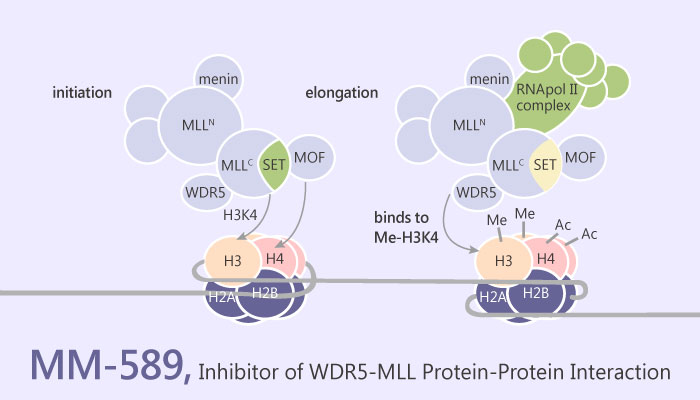Acute leukemia is a kind of serious diseases, includes acute myeloid leukemia, acute lymphoblastic leukemia and blast crisis of chronic myelogenous leukemia. MLL1 (Mixed-lineage leukemia 1; KMT2A) is a histone methyltransferase, occurs in leukemia cells in a mutation form. MLL1 interacts with WD repeat domain 5 protein (WDR5), enhances its enzymatic activity. Thus, inhibition of MLL1- WDR5 interaction may become an effective way to treat acute leukemia. MM-589, a potent WDR5-MLL interaction inhibitor, stands out.
Researchers made great efforts to find out the promising inhibitor.
First of all, they screen several compounds. They identify several non-peptide small molecules as WDR5−MLL interaction inhibitor. Among them, compound 18 (MM-589) is the most effective one.

Next, they detect the mechanism of the MM-589. They find that MM-589 binds to WDR5, with an IC50 value of 0.9 nM. It shows high affinity, and the Ki value is < 1 nM. The compound is cytotoxic to MLL, but has no effect on other SET1 family members. The latter contains MLL2, MLL3, MLL4, SET1a and SET1b. MM-589 exhibits an IC50 of 12.7 nM against MLL HMT activity.
Then, researchers measure the activity of MM-589 against acute leukemia cancer cells. As a result, the product significantly inhibits the growth of MV4-11 and MOLM-13 cell lines. IC50s are 0.25 and 0.21 μM, respectively. However, it weakly suppresses the HL-60 cell line growth, with an IC50 of 8.6 μM.
Finally, MM-589 is a potent and cell-permeable inhibitor of WDR5-MLL interaction. Further study need to find out more potential of the compound against acute leukemia.
References:
1. Karatas H, et al. J Med Chem. 2017 Jun 22;60(12):4818-4839.